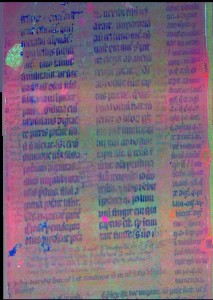While conducting research on slotted parchment bindings, Hesiodou tou Askraiou Erga kai Hemerai (Hesiod 1537) came to the attention of preservation staff. We could tell from visual inspection that the covers were composed of a manuscript whose text had been scraped off on one side. The parchment was then reused to cover the book. The reuse of material has a long tradition in bookbinding. A well-documented example is the Archimedes Palimpsest. Since the parchment was only scraped on one side, we could see part of the manuscript on the other un-scraped side of the parchment. We reached out to Northwestern University/Art Institute of Chicago Center for Scientific Studies in the Arts (NU-ACCESS) to learn more about the manuscript, its central text, and the surrounding commentary. NU-ACCESS is a collaborative initiative aimed at broadening the reach of scientific studies within the art and conservation fields.
The scientists at NU-ACCESS examined the text using hyperspectral imaging and x-ray fluorescence (XRF). Hyperspectral imaging allowed us to view the parchment covers outside visible light range. Using filters, various wavelengths were isolated and the writing became visible.
XRF is a non-destructive technique used for elemental analysis and is often used as an analytical tool for cultural material such as ceramics, painting, and murals. By isolating the iron element found in the iron gall ink, the manuscript writing became much more visible.
Once the text became visible, it was identified as an excerpt from Justinian’s Institutes. Unfortunately, the commentary is too fragmentary to identify a source.

The project successfully demonstrated the use of XRF to make previously illegible writing visible, solving a mystery within our collection. This was a collaborate effort that brought together subject experts in a variety of fields and strengthened relationships across campus.
We are very grateful for the expertise provided by colleagues at Northwestern University and NU-ACCESS: Oliver Cossairt, Noalle Fellah, Charikleia Iakovidou, Aggelos Katsaggelos, Emeline Pouyet, Johanna Salvant, Louisa Smieska, Marc Walton, Arthur Woll, and to Professor Richard Keickhefer.






